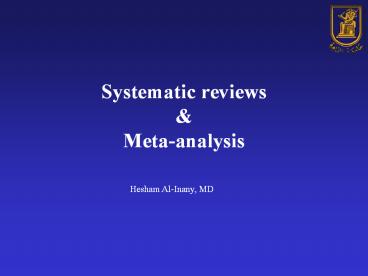Systematic reviews - PowerPoint PPT Presentation
1 / 24
Title:
Systematic reviews
Description:
It is a structured review integrating statistical analysis of ... Allocation concealment : adequate (A), unclear (B), or inadequate (C). Description of studies ... – PowerPoint PPT presentation
Number of Views:38
Avg rating:3.0/5.0
Title: Systematic reviews
1
Systematic reviewsMeta-analysis
Hesham Al-Inany, MD
2
What is a systematic review?
- It is a structured review integrating statistical
analysis of the results from a collection of
individual studies.
3
Meta-analysis
- A statistical analysis that combines or
integrates - the results of several independent clinical
trials considered by the reviewer to be
'combinable.'
4
Significance of Meta-analysis Example
- Mitchell JRA. Timolol after myocardial
infarction an answer or a new set of questions?
BMJ 19812821565-70 - "despite claims that they reduce arrhythmias,
cardiac work, and infarct size, we still have no
clear evidence that ß blockers improve long-term
survival after infarction despite almost 20
years of clinical trials."
5
Graphic Displayß blockers in secondary
prevention after myocardial infarction.
6
Cumulative Meta-analysis
7
Steps to do
- Well-Formulated Question
- Efficient Search Strategies
- Review Abstracts to Determine Eligibility
- Apply Strict Inclusion/Exclusion Criteria
- Extract the Data
- Perform the Required Analyses (Meta-analysis)
- Interpret the Results
- Determine Implications for Health Care Policy and
Practice
8
Methodology
- At least 3 reviewers
- Trial design characteristics
- Method of randomisation
- Design (e.g. parallel or crossover)
- blinding
- power calculation
- Source of any funding
- Allocation concealment adequate (A), unclear
(B), or inadequate (C).
9
Description of studies
- Why included / excluded
- Quality of included studies in details
- Sample size of each
10
Standardization of measures of outcome
- Odds and odds ratio
- The odds is the number of patients who fulfill
the criteria for a given endpoint divided by the
number of patients who do not. - For example, the odds of diarrhoea during
treatment with an antibiotic in a group of 10
patients may be 4 to 6 (4 with diarrhoea divided
by 6 without, 0.66) in a control group the odds
may be 1 to 9 (0.11). The odds ratio of treatment
to control group would be 6 (0.660.11).
11
Risk and relative risk
- The risk is the number of patients who
fulfill the criteria for a given end point
divided by the total number of patients. - For example, the risk of diarrhoea during
treatment with an antibiotic in a group of 10
patients may be 4 to 10 in the control group the
risks may be 1 to 10. The relative risk of
treatment to control group would be 4 (0.40.1)
12
Some Controversies About Meta-Analysis
- Quality of Studies
- Many Small Studies or One Big Study?
- Publication Bias
- Fixed- or Random-Effects Models?
13
Repeat the analysis
- Excluding the unpublished studies (if there were
any) - Excluding studies of the lowest quality
- If there were one or more very large studies, the
analysis would be repeated excluding them to look
at how much they dominate the results.
14
Publication Bias
15
Select your statistical model
- Fixed effects Assumes that there is a single
fixed treatment effect no interaction between
study and effect of intervention - Random effects Assumes different treatment
effects of the intervention in different studies
16
Random-Effects Models
- the confidence interval will be wider
- less certainty in conclusions
- The Cochrane Library use Fixed effect model
17
Human Albumin Model
- The objective was to review the effectiveness of
human albumin administration in prevention of
severe ovarian hyperstimulation syndrome
18
Search strategy
- MEDLINE,
- EMBASE,
- The MDSG specialised register
- Abstracts from conferences
- handsearching of core journals
- contact with authors of relevant papers.
19
Selection criteria
- Only randomised controlled studies
20
R.R
21
NNT
- 2.2 in albumin group / 7.7 in control group
- absolute risk reduction was 5.5
- NNT 1/ARR
- For every 18 women at risk of severe OHSS,
albumin infusion will save one more case.
22
Caution
- Whether this NNT would justify the routine use of
albumin infusion in cases at risk of severe OHSS
needs to be judged by clinical decision makers.
23
Keep in mindEvidence may change with more trials
24
Thank You































